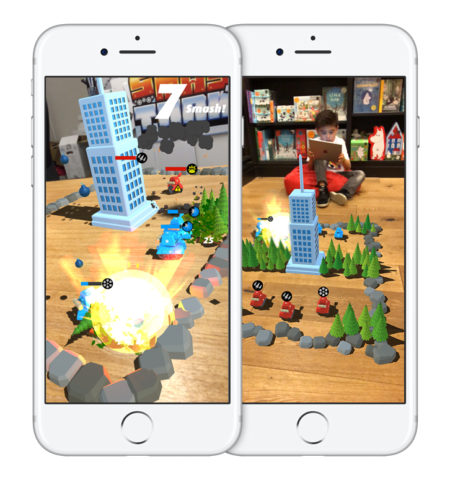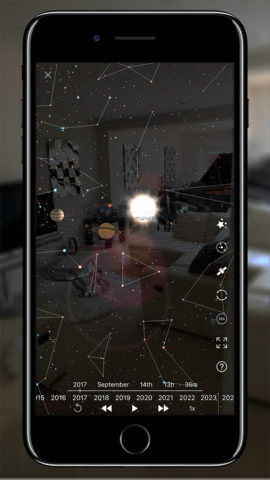We investigate ARKit, and speak to the people working on the next generation of immersive iOS apps
Apple says augmented reality (AR) apps can “change your world”. It means this more literally than you might imagine, because AR is all about blending digital objects with your local environment. The aim is to fuse the virtual and the real, so you can interact in new ways with immersive digital experiences.
You might question this for all manner of reasons. Notably, Apple illustrates AR on its website with a massive dinosaur stomping along a beach road (with people rather weirdly blithely ignoring the terrible giant). This smacks of gimmick. Also, weren’t we all told the next big thing would be virtual – not augmented – reality?
But once you’ve dipped your toes into ARKit apps, you’re going to be a convert. Because although there’s already plenty of AR dross stinking up the App Store, the best AR apps and games create unique, engaging iPhone experiences, echoing the dizzying feeling you got when first trying multitouch.
As for VR, that’s all very well – until you realize you need a headset. By contrast, AR is always available on the device in your pocket – albeit with the limitation of experiencing the melding of the real and unreal through the ‘window’ of your iPhone’s display.
Still, until we’re all sporting iGlasses, AR’s the next best thing.
ARKit GO
But why are we writing about this now? AR is nothing new, even on iPhone. Most famously, Pokémon GO in 2016 peppered streets and woodland with countless virtual monsters, which millions of eager players used iPhones to hunt and hoover up.
The difference today is ARKit, baked deep into the heart of iOS 11. In short, this framework accurately tracks the world, utilizing camera and motion sensor data. It detects how your device is moving within 3D space, without additional calibration. And it quickly locates horizontal planes, onto which apps can ‘place’ virtual objects. Further adding to the realism, ARKit applies lighting based on local conditions, so AR objects don’t stick out like a sore thumb.
Regardless of the hardware you’re using (ARKit requires an iPhone 6s or newer, an iPad Pro, or the latest 9.7-inch iPad), the result is fluid, responsive and fast. But from the point of view of the people creating the apps, perhaps the most important thing is that it is ‘free’.
Freedom to innovate
Ex-teacher Andy Weekes is the founder of astronomy app Night Sky, which now includes an AR orrery. This enables you to walk around the solar system, watching space missions, manipulating time and space with your fingertips. Weekes says within days of ARKit’s arrival in June, his team had the basics up and running. “It just works,” he jokes, in a nod to that well-worn phrase about Apple. And as a virtual satellite zips past Jupiter, he adds, smiling: “From a learning point of view, AR is phenomenal”.
This sense of immediacy in ARKit is echoed by games developers. Dave Ranyard of Dream Reality Interactive is currently working on Orbu. Essentially an AR take on mini-golf, with slingshot Angry Birds-style controls, it finds you flinging strange little creatures across Japanese-themed courses, feeding fish along the way.
Referring to the title’s AR aspect, Ranyard explains: “To have it for ‘free’ is amazing. If we’d had to do all this ourselves, it would have taken years. And it might not be a path you’d go down – it’s just too big.” But with ARKit dealing with much of the technical side of things, the creativity of makers is unlocked. “We’re thinking of putting in some levels that are really huge,” mulls Ranyard, “where you have to go to an outside space to play them”. Virtual mini-golf in the real world – ideal for fans who don’t live near a course.
Tanks to ARKit
Travis Ryan, co-founder of Dumpling Design, is another games creator happy to enthuse about ARKit. His in-progress multiplayer title Smash Tanks involves pinging cartoon tanks around a board. It arrived from a love of the tactile board games he plays with his son.
The basic concept had been around for a while, but Ryan’s small team of three couldn’t realize it in a satisfactory manner. “But when ARKit was announced, it was like a load of lightbulbs went off,” he says. “Within a couple of hours, we had our game working, and were wandering around our office, looking at all the tanks.”

Virtual warfare with Smash Tanks
The game suddenly clicked. Ryan says players quite naturally start exploring the board the second they start playing. And that board can be placed on a table, or be resized to fill a room, depending on the wishes of each player. (Try doing that with a traditional board game!) “Yet without ARKit, we wouldn’t have been able to touch this,” says Ryan. “We’re three guys in a room. Solving problems like surface detection and anchoring would have taken months and months of developer time we couldn’t justify. With ARKit, we could just get on with making the game.”
An augmented future
It’s still early days for ARKit, and it’s worth remembering every app and game creator eagerly showing off their wares only found out about the technology at the same time as everyone else, a few short months ago. That many have already managed to fashion such smart, interesting, unique products is pretty amazing. (Look out for a round-up of our favorites soon.)
Cynics might argue ARKit still isn’t entirely necessary. Many existing and upcoming games could have been refashioned into something similar without it. And although it’s useful to have IKEA Place and Housecraft dump virtual furniture all over your home, that doesn’t scream ‘killer app’.
ViewRanger just might though. This navigation app works entirely offline, and is primarily aimed at hikers. With it installed, they no longer need to match up book illustrations to distant peaks, or peruse maps with a furrowed brow to figure out where they are. Instead, mapping and other information can be placed directly onto the landscape, so the landscape itself is more easily understood.
Company founder Craig Wareham lifts his iPhone to show off the app, excitedly talking about how you can also leave virtual breadcrumb trails, so you’ll never get lost, and how the ARKit-powered app can enable teams of search and rescue people to quickly track each other’s positions using their phones.
Very suddenly, and just a few months in, ARKit seems a long way from a gimmick – more a technology already coming of age.




